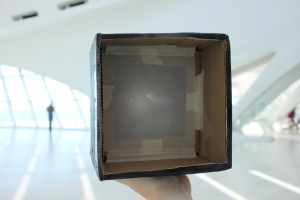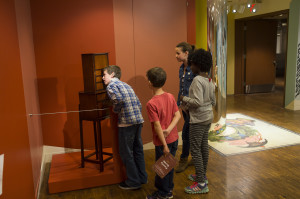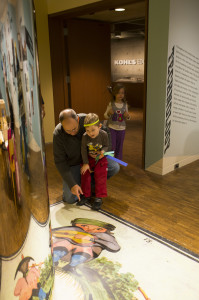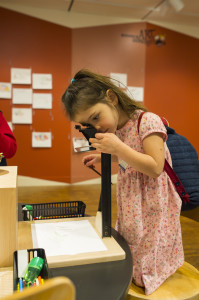For additional resources, see the Kohl’s Art Generation Online Lab & Gallery guide.
Throughout time, artists have used new technology to help them make a better picture. Do you think it is cheating for artists to use drawing aids? We don’t think so! Optical devices are tools artists sometimes use to help them make their images look realistic. Optical devices do not come up with the idea, the mood, or the composition of a picture; artists do that. Artists need great skill to create an image, whether it is with pencil, paint, or even light. Below you will find a timeline of the different tools artists have used to create their images, as well as activities in which you will make and use your own optical devices!

Camera Obscura (1,000 CE) The camera obscura is a portable box that uses sunlight to make an image. The sun’s rays pass through a small hole, where they cross, and then fan out on the other side, forming a reduced, upside-down image on the opposite wall. The projected image is in full color, but blurry. Mirrors and prisms are used to adjust the angle of the light rays to focus and correct (turn right side up) the image. In the seventeenth, eighteenth, and nineteenth centuries, the camera obscura helped many artists make their masterpieces, including Vermeer, Canaletto, and Guardi. The device was the beginning for modern cameras. Photographers today, such as Jerry Uelsmann, still use the camera obscura to create dreamlike image. You can make your own camera obscura (example above)! Use these instructions to create your own version of this artist’s tool. What will you draw with your camera obscura? Many artists draw still-life compositions. You could use dollhouse (miniature) furniture or Legos to create a scene to draw, or fruit and vegetables to make a landscape—broccoli makes a great tree!

Peepshow Box (1650s) The Dutch master Samuel Van Hoogstraten (1627–1678) was a pupil of Rembrandt’s, but his perspective peepshows made him famous. The peepshow is a box with a painted interior. Looking into the box through a small “peephole” reveals a three-dimensional scene. Hoogstraten’s peepshow manipulates simple central perspective and its distorted (or anamorphic) form to create its magical world. The peephole allows the viewer to use only one eye to peer into the box. This one-point perspective confuses the brain and the viewer’s judgment of scale and depth. The peephole also places the viewer precisely opposite the vanishing point of the painted panels inside. As a result, the distinction between real space and painted space is blurred. Watch a video about Hoogstraten’s peepshow box here. What are your favorite parts of the box? Can you think of a modern-day equivalent to the peepshow box?

Anamorphic Images (1700) In the eighteenth and nineteenth centuries, semicircular anamorphic (or distorted) images were popular. When the distorted images, which consist of curved lines, are reflected in a cylindrical mirror, they appear normal to the viewer. The same mirror would make normal images appear grossly distorted. Sometimes artists embedded anamorphic images in their paintings. Can you find the anamorphosis in this famous painting? Can you find the position where it no longer looks distorted? You may need to stand up and move around to find the right angle.

Timeline—History of Illusions
Journey with us back in time to track the history of creating the illusion of depth in art!

